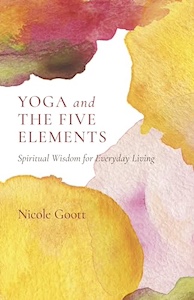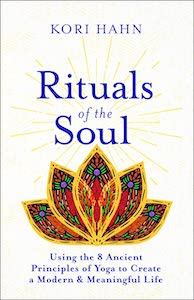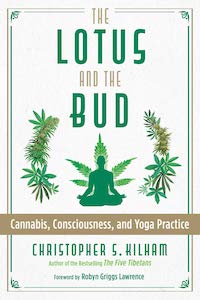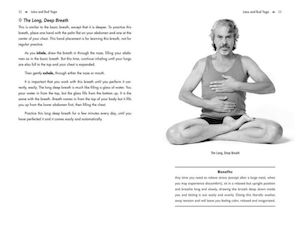
Yoga and the Five Elements: Spiritual Wisdom for Everyday Living, by Nicole Goott
Mantra Books, 978-1803412672, 208 pages, December 2023
“The five elements of earth, water, fire, air and space are easily recognizable as forces existing around us all the time. As with the axion, we are a microcosm of a larger macrocosm, this is true of the five elements existing not only around us in the Natural world but also within us, in both physical and metaphysical terms.1
Yoga and the Five Elements: Spiritual Wisdom for Everyday Living by Nicole Goott is an interesting read that focuses on Eastern practices but can be seamlessly woven into any spiritual practice to make a deeper connection to a fivefold-structure of being. The book is separated into twelve chapters and covers from start to finish a well-structured plan of approach to the subject matter.
This thoughtful manner of disseminating information is carried out from the start with the addition of a few pages of note regarding Sanskrit and transliteration.This little addition offers accessibility to all regardless of your familiarity with the terminology commonly found in Eastern studies and practices.
Goott provides the reader background in the Introduction for her seeking of the origins of the five elements as applied to Indian philosophy. I appreciated her story of searching in Martial Arts practices, Ayurvedic disciplines, Hatha Yoga, as well as Tantric and Vedic literature. This demonstrates a well-intentioned approach rather than the cursory attempts at finding overlays and connections that may not truly be found.
The concluding sections (of more than 20+ pages) are supportive of those readers wishing to explore further and are inclusive of References, Further Reading, a robust Bibliography, Glossary and Index; something not always included as a source of quick reference for a title such as this.
Chapters 1-3, covering subtle bodies, cosmic principles, and the five elements, are invaluable resources and lay a dense and comprehensible foundation before moving out into deeper exploration of each of the five elements separately. Chapters dedicated to related concepts and knowledge can be found in “Chapter 7: Mind”, “Chapter 9: Karma”, and “Chapter 10: Space”. Finally, all that has been learned in previous chapters is integrated and put into practical application with “Chapter 11: Balancing the Elements” and “Chapter 12: Heart Consciousness”.
I especially enjoyed “Chapter 9: Karma” and the way in which Goott has interwoven a concept that has many interpretations and levels of understanding. She dispels the common thoughts around karma and proposes that it is not something over which we have no control because of the “bad “ or “good “ stuff we did. Instead she gives a very hopeful definition:
“Using the analogy of an apple tree… the causal chain begins with a seed (thought) like the seed of an apple (form). This seed is full of potential , holding within itself the possibility to create a new tree (manifested form). It may or may not germinate if the conditions required are not present….when a seed does take root, all the potential that was dormant now begins to ripen. A tree is born (results).”2
She then aligns karma with the element of fire in its aspect as the “light of illumination, wisdom and higher knowledge or insight”3. This reminds the reader of our nature as creator of our own realities and consequential scenarios.
Goott provides charts of comparison of the elements and approach throughout the book, supporting a broader perspective of mind that is not simply limited to the Vedic practices. There are exercises, questions, journaling suggestions and more to allow the reader true experiential moments of the five elements and how their dynamics change depending on the context. And, adequate reference is given to writers such as Annie Besant and the Theosophical spin on the elements, and their use.
Would I Recommend?
Yoga and the Five Elements is an important read intended to be digested, integrated, put into action and then returned to frequently. Regardless of spiritual practice, the broad approach to the fundamental organic make-up of humanity, the world we inhabit and the Cosmos of which we are a part, provide the tools for stepping more fully into who we are meant to be, especially now as we stand at a crossroads as a species that has increasingly become disconnected from ourselves and others. The quote below beautifully sums up the reasons why this book and its studies are so important, particularly now:
“We can embrace the lessons we are given or resist them. The degree to which we embrace each step along our path determines the level of satisfaction and joy we experience…the more that each of us wakes up to the realization that we are so much more than the brain’s chemical processes and imperfect body, the greater the possibility for the collective consciousness to rise to its fullest potential.”4
About the Author: Nicole Goott
Goott is a teacher, author, advisor, and spiritual healer motivated to guide others in their journey of self-discovery and how to live a joy-filled life. Born and raised in Johannesburg, South Africa, Nicole moved to the United States when she was twenty-four years old. For two decades she has studied Yoga, Ayurveda, and related healing arts practices, as well as mindfulness-based approaches to self-healing. Learn more about Nicole’s work at her website.

Robin Fennelly is an Elder within the Assembly of the Sacred Wheel Tradition [www.sacredwheel.org]. She is a dancer, teacher, astrologer, author, ritualist and seeker of all things of a spiritual nature. Her writings and classes incorporate a deep understanding of Eastern practice and Western Hermetics and bring a unique perspective towards integration and synthesis of the Divine and Mundane natures of our being. She is a mother of five and lives in Eastern PA with her husband of 45+ years.










